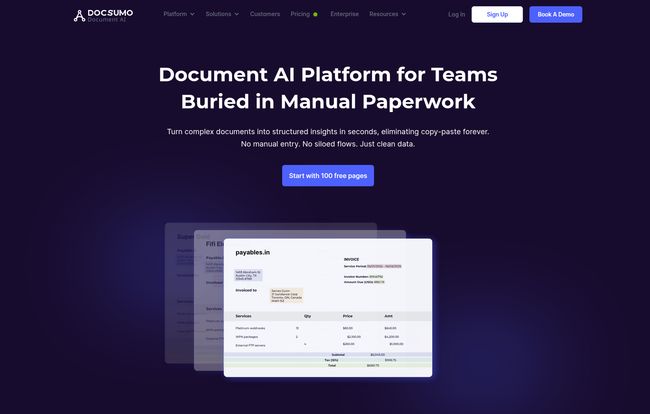Let’s have a little heart-to-heart. If you’ve ever spent an afternoon staring at a mountain of invoices, receipts, or contracts, you know the special kind of dread that comes with manual data entry. It’s the digital equivalent of digging a ditch with a spoon. Your eyes glaze over, your posture collapses, and you start to question all your life choices. I’ve been there. I’ve managed campaigns for clients who were literally drowning in paperwork, their growth choked by the sheer volume of information they had to process by hand.
For years, we've been promised a paperless office, but what we got was a mess of PDFs, JPEGs, and scanned documents that still needed a human to read and interpret them. Well, I recently stumbled upon a platform called Docsumo, and it’s one of the first tools in a long time that made me sit up and say, “Huh. They might have actually cracked it.” It’s an Intelligent Document Processing (IDP) platform, which is just a fancy way of saying it’s an AI that reads documents so you don’t have to. But does it live up to the hype?

Visit Docsumo
What Exactly is Docsumo? (Beyond the Tech Buzzwords)
Okay, so on the surface, Docsumo says it “automates data extraction from unstructured documents.” Yawn. We’ve heard that before, right? Old-school OCR (Optical Character Recognition) has been around for ages, and it’s… fine. It can turn a picture of text into actual text. But it's also famously dumb. It doesn't understand context. It won't know that “Invoice #” is a field label and “12345” is the value you actually need.
This is where Docsumo is different. Think of it less like a simple scanner and more like a junior-level analyst you’ve just hired. An analyst who can read thousands of pages in minutes, never gets tired, and, according to their stats, makes fewer mistakes. It uses AI to not just read the document, but to understand it. It identifies key information—like names, dates, line items, and totals—and pulls it out into structured, usable data. Like a spreadsheet. A glorious, clean, automatically-generated spreadsheet.
It’s designed to be the bridge between your messy pile of documents and the clean data your other software systems need to function. And honestly, for many businesses, that bridge is on fire. Docsumo wants to be the firefighter.
The Features That Genuinely Make a Difference
A feature list is just a list until you see how it solves a real problem. Docsumo has a bunch of them, but a few stood out to me as being particularly clever and, more importantly, useful.
From Scanned Mess to Structured Success
The whole process starts with getting your documents in. Docsumo isn’t picky. You can upload PDFs, scans, images, you name it. Its pre-processing magic straightens skewed pages, removes noise, and generally cleans things up before the AI even gets to work. Then, the data extraction kicks in. The platform comes with pre-trained models for common documents like invoices, bank statements, and ID cards. This means you can often get going right out of the box without some long, drawn-out setup process. For anyone who has wrestled with enterprise software before, this is a huge sigh of relief.
The Human-in-the-Loop Safety Net
Here’s something I really appreciate: they’re not pretending the AI is infallible. We all know AI can get a little… creative sometimes. For documents that are particularly weird or for fields where the AI’s confidence is low, the system flags them for a Human-in-the-Loop review. A real person (one of your team members) can quickly glance at the flagged item, make a correction, and approve it. This isn't a failure of the system; it’s a feature. It builds trust and ensures you’re not blindly accepting wonky data. Plus, every correction you make helps train the model to be smarter next time. It's a brilliant feedback loop.
You Can Train Your Own AI Specialist
What if you don’t work with standard invoices? What if you’re a logistics company dealing with custom bills of lading, or a law firm with unique deposition formats? This is where the “Train your AI Model” feature comes in. You can teach Docsumo how to read your specific, niche documents. You just upload a few examples, highlight the data points you want to extract, and the AI learns. This transforms it from a generic tool into a bespoke solution for your exact workflow. That's powerful stuff.
How This Actually Impacts Your Business Operations
So, cool tech. But what does it mean for your traffic, your conversions, your bottom line? The claims are bold: 99% accuracy and a 10x increase in efficiency. Are they realistic?
In my experience, a '10x' claim in tech marketing should usually be taken with a grain of salt. But in the context of replacing manual data entry, it's actually… plausible. If it takes an employee 5 minutes to process one invoice, and Docsumo can do 100 in that same time (with a few exceptions for human review), the math checks out. The time saved is enormous. It frees up your team to focus on high-value work instead of being data-entry drones. Think better customer service, more sales calls, or deeper business analysis.
The accuracy part is also a huge money-saver. Fewer data entry errors mean fewer billing disputes, better compliance, and more reliable financial reporting. It’s one of those 'boring' improvements that quietly adds thousands of dollars back to the bottom line.
Let's Talk Turkey: Docsumo's Pricing Structure
Alright, this is the part where most SaaS tools get cagey. I was pleasantly surprised to see Docsumo lays it all out pretty clearly. No “Contact us for a quote” nonsense unless you’re a massive enterprise.
Here’s a rough breakdown based on their monthly plans:
- Free: $0 for up to 100 pages. A great way to kick the tires and see if it works for your documents.
- Starter: $299/month for 1,000 pages. Good for small businesses or departments just getting started with automation.
- Growth: $799/month for 3,000 pages. This seems to be their sweet spot for growing businesses.
- Pro: $1,499/month for 5,000 pages. For companies with more significant document volume.
- Enterprise: Custom pricing. This is for the big players with massive volume and needs for things like dedicated support and SOC 2 compliance.
Now, is it cheap? No. But you’re not buying a simple app; you’re investing in a workflow automation engine. You have to weigh the monthly cost against the hours of manual labor it saves. If you’re paying an employee $25/hour, and this tool saves them even 15-20 hours a month, it pays for itself pretty quickly.
The Good, The Not-So-Good, and The AI-Powered Reality
No tool is perfect. Let's get real about the pros and cons.
On the plus side, the high accuracy, the efficiency gains, and the custom APIs for integration are huge wins. The security is also top-notch, with end-to-end encryption and compliance baked in, which is critical when you’re handling sensitive data. The pre-trained models are a fantastic starting point for most businesses.
On the flip side, the pricing, while justifiable, could be a hurdle for very small startups or solo entrepreneurs. It’s a tool built for businesses that already have some volume. It also requires integration to be truly effective. It’s not a standalone island; its power comes from feeding clean data into your existing CRM, ERP, or accounting software. That means you’ll need some technical know-how (or a developer) to set up the APIs. Finally, you are placing a lot of trust in the AI. While the human-in-the-loop feature mitigates this, it's a mental shift for teams used to controlling everything manually.
So, Should You Give Docsumo a Shot?
After digging into Docsumo, I'm genuinely optimistic. It feels like a mature, well-thought-out solution to a problem that has plagued businesses for decades. It's not a magic wand, and it requires a bit of an investment in both money and setup time. But for any company that feels like its drowning in documents, it’s a mighty compelling life raft.
It represents a shift from just digitizing paper to actually making digital documents intelligent. If your team is spending more time typing than thinking, you owe it to yourself to at least try their free plan. Upload a few of your most annoying documents and see what it spits out. You might be surprised. You might even get an afternoon of your life back. And what’s the ROI on that?
Frequently Asked Questions about Docsumo
- 1. What kind of documents can Docsumo process?
- It's built to handle a wide variety of unstructured and semi-structured documents. It has pre-trained models for common types like invoices, purchase orders, receipts, bank statements, and ID cards. You can also train it on custom document types specific to your industry.
- 2. Is my data secure with Docsumo?
- Security seems to be a major focus. They mention end-to-end data encryption, multi-region data architecture for compliance with regulations like GDPR, and 24/7 monitoring. For enterprise clients, they offer advanced security features and compliance certifications like SOC 2.
- 3. Do I need to be a developer to use Docsumo?
- Not necessarily for the basic functions. The user interface is designed to be fairly intuitive for uploading documents and reviewing data. However, to get the most out of it by connecting it to your other software (like QuickBooks or SAP), you or someone on your team will need experience with APIs.
- 4. What happens if the AI makes a mistake?
- This is what the 'Human-in-the-Loop' feature is for. The system flags data points it's not sure about, allowing a human user to quickly verify or correct the information. This ensures accuracy and helps improve the AI model over time.
- 5. Can I really try it for free?
- Yes, they offer a free plan that includes 100 pages of processing. This is a great way to test its capabilities with your own documents before committing to a paid plan.
- 6. How is this different from a standard OCR tool?
- Standard OCR converts an image of text into text characters but doesn't understand context. Docsumo's Intelligent Document Processing (IDP) goes a step further by using AI to understand the layout and context of the document to extract specific fields and their corresponding values, essentially turning a whole document into structured data.



